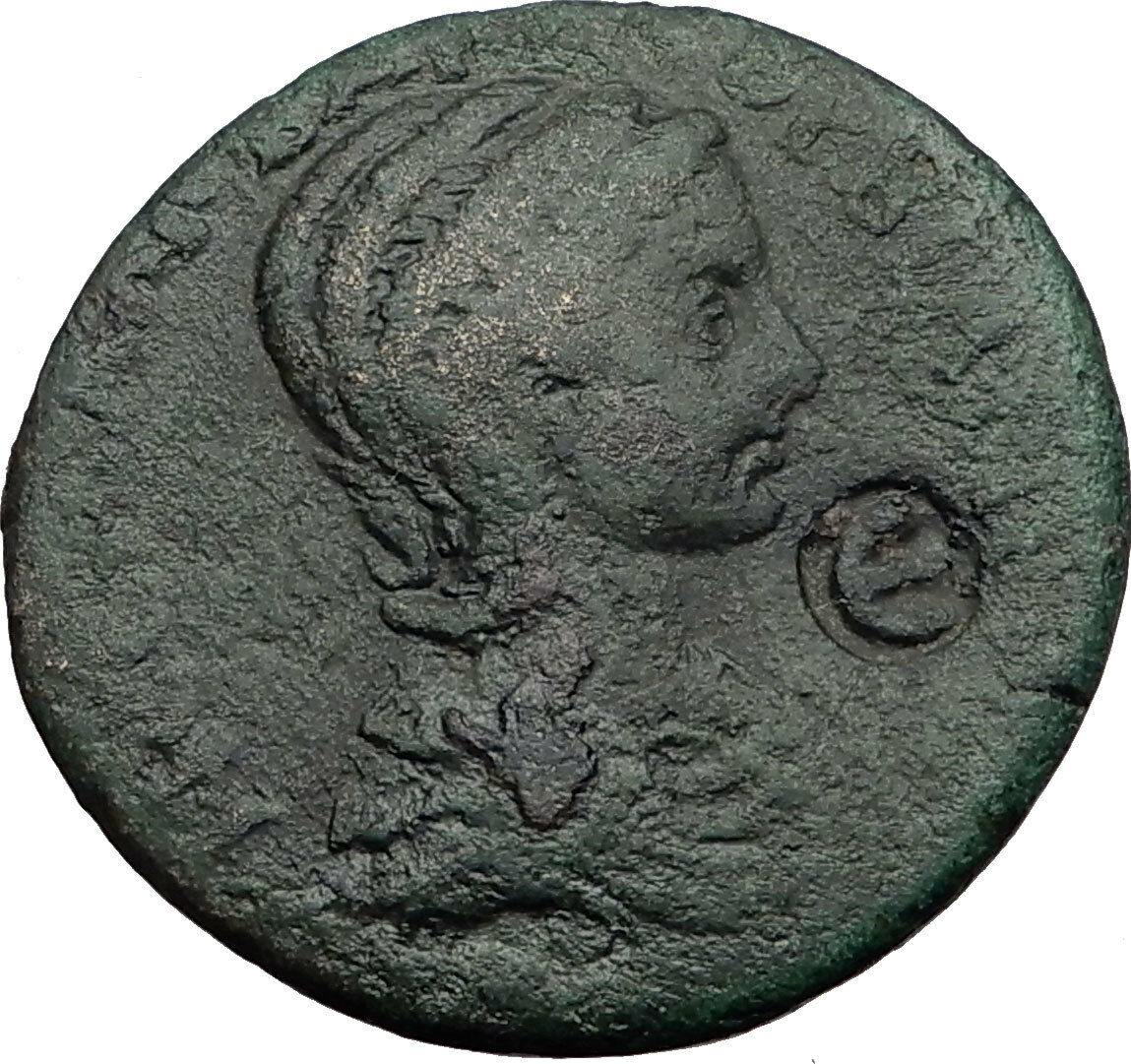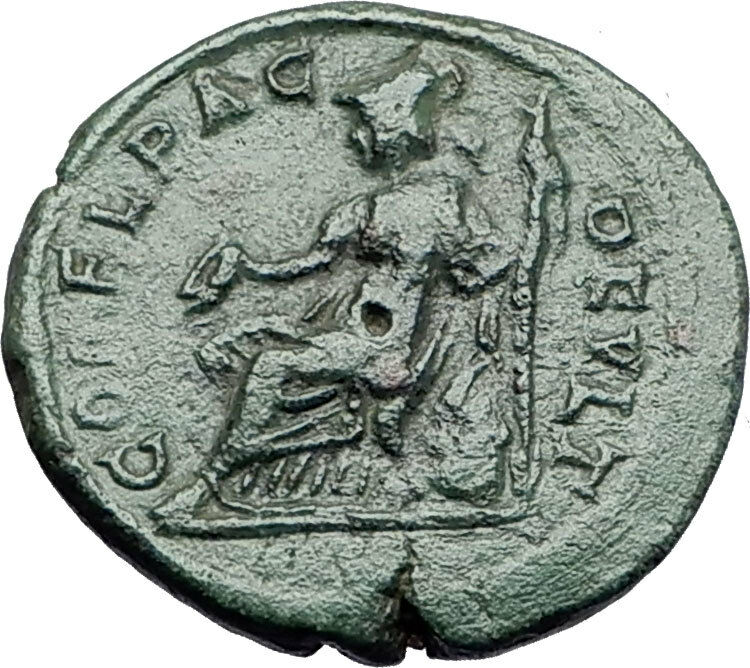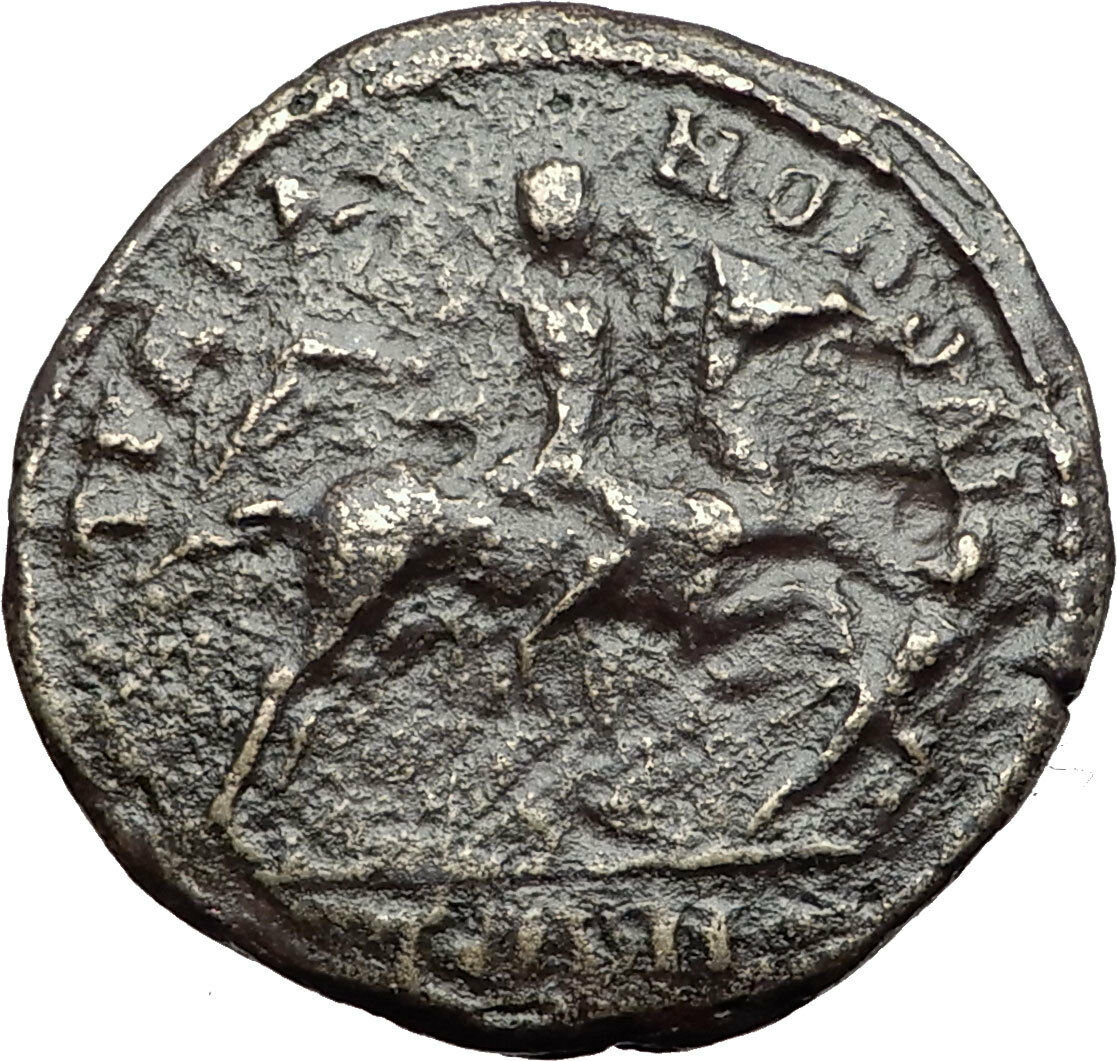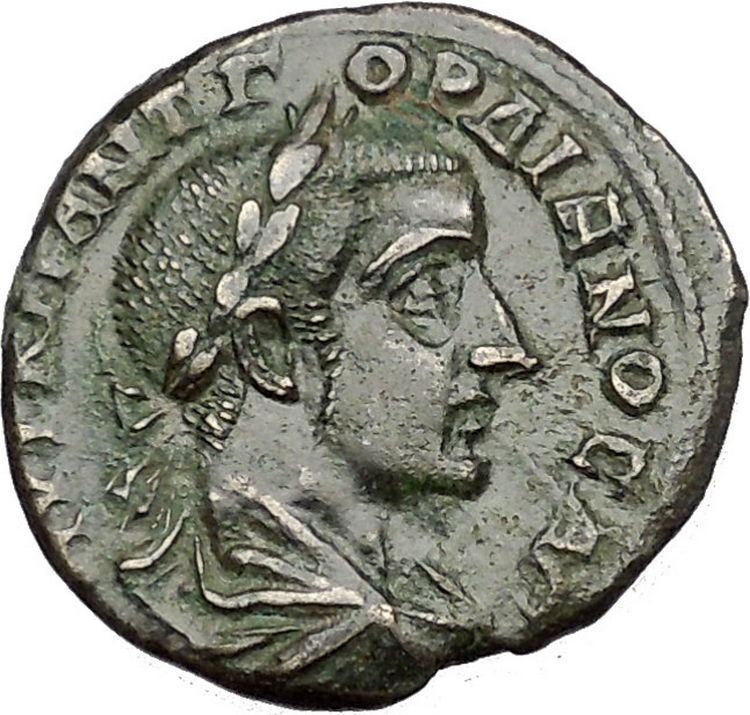|
Caracalla
–
Roman Emperor
: 198-217 A.D. –
Bronze 17mm (3.01 grams) of
Nicopolis ad Istrum
in Moesia Inferior
Bare-headed, draped and cuirassed bust right.
NIKOΠOΛITΩN ΠPOC I,
Serpent
peering out of half-open cista
mystica.
You are bidding on the exact item pictured,
provided with a Certificate of Authenticity and Lifetime Guarantee of
Authenticity.
In the
Mystery cult
, a cista mystica (literally
“sacred chest”) is a basket or chest used to house snakes. Cistae mysticae were
used in the initiation ceremony of the cult of Bacchus, or
Dionysus,
as well as an early
gnostic
sect called the
Ophites.
Cistae mysticae appear on ancient Roman and Greek coins.

A cista (kiste) in the classical world was generally a casket, used
for example to hold unguents or jewels. More specifically, in the
Mystery cult
, a cista mystica (literally
“sacred chest”) is a basket or chest used to house snakes. Cistae mystica were
used in the initiation ceremony of the cult of Bacchus or
Dionysus
, as well as an early
gnostic
sect called the
Ophites
. Cistae mysticae appear on ancient
Roman and Greek coins.
Furthermore small Cistas were worked in Etruria, contained in cylindrical
bronze containers for domestic use and storage of toiletries. Their faces were
usually adorned engraved with figures, soldered on the top small bronze figures.
The Cista could be realised with different materials like wicker, wood,
rawhide, but above of all in metal, used from the 5th century. The Etruscans
manufactured it in different qualities from the 5th century, at first in ovoid
form with thrown scenes, and then in cylindrical form with engraved scenes. The
handle of the lid was consisted by little structures. One of the most important
city of production of Cista is Preneste, an old city of Lazio, which realised
different types of Cista from the 4th century.

Serpents
and snakes play a role in many of the world’s myths and legends. Sometimes these
mythic beasts appear as ordinary snakes. At other times, they take on magical or
monstrous forms. Serpents and snakes have long been associated with good as well
as with evil, representing both life and death, creation and destruction.
Serpents and Snakes as Symbols. In religion, mythology, and
literature, serpents and snakes often stand for fertility or a creative life
force—partly because the creatures can be seen as symbols of the male sex organ.
They have also been associated with water and earth because many kinds of snakes
live in the water or in holes in the ground. The ancient Chinese connected
serpents with life-giving rain. Traditional beliefs in Australia, India, North
America, and Africa have linked snakes with rainbows, which in turn are often
related to rain and fertility.
As snakes grow, many of them shed their skin at various times, revealing a
shiny new skin underneath. For this reason snakes have become symbols of
rebirth, transformation, immortality, and healing. The ancient Greeks
considered snakes sacred to Asclepius, the god of medicine. He carried a
caduceus, a staff with one or two serpents wrapped around it, which has become
the symbol of modern physicians.
For both the Greeks and the Egyptians, the snake represented eternity.
Ouroboros, the Greek symbol of eternity, consisted of a snake curled into a
circle or hoop, biting its own tail. The Ouroboros grew out of the belief that
serpents eat themselves and are reborn from themselves in an endless cycle of
destruction and creation.
Serpents figured prominently in archaic Greek myths. According to some
sources,
Ophion (“serpent”, a.k.a. Ophioneus), ruled the world with Eurynome
before the two of them were cast down by Cronus and Rhea. The oracles of the
Ancient Greeks were said to have been the continuation of the tradition begun
with the worship of the Egyptian cobra goddess,
Wadjet.
The
Minoan
Snake
Goddess brandished a serpent in either hand, perhaps evoking her role
as source of wisdom, rather than her role as Mistress of the Animals (Potnia
theron), with a leopard
under each arm. She is a Minoan version
of the Canaanite
fertility goddess
Asherah.
It is not by accident that later the infant
Heracles,
a liminal hero on the threshold between the old ways and the new Olympian world,
also brandished the two serpents that “threatened” him in his cradle. Classical
Greeks did not perceive that the threat was merely the threat of wisdom. But the
gesture is the same as that of the Cretan goddess.
Typhon
the enemy of the Olympian gods is described as a vast grisly monster with a
hundred heads and a hundred serpents issuing from his thighs, who was conquered
and cast into Tartarus
by
Zeus,
or confined beneath volcanic regions, where he is the cause of eruptions. Typhon
is thus the chthonic figuration of volcanic forces. Amongst his children by
Echidna are Cerberus
(a monstrous three-headed dog with a
snake for a tail and a serpentine mane), the serpent tailed
Chimaera
, the serpent-like chthonic water beast
Lernaean Hydra and the hundred-headed serpentine dragon
Ladon.
Both the Lernaean Hydra and Ladon were slain by
Heracles.
Python
was the earth-dragon of
Delphi,
she always was represented in the vase-paintings and by sculptors as a serpent.
Pytho was the chthonic enemy of Apollo
, who slew her and remade her former home
his own oracle, the most famous in Classical Greece.
Amphisbaena a Greek word, from amphis, meaning “both ways”, and
bainein, meaning “to go”, also called the “Mother of Ants”, is a mythological,
ant-eating serpent with a head at each end. According to Greek mythology, the
mythological amphisbaena was spawned from the blood that dripped from
Medusa
the Gorgon‘s
head as
Perseus flew over the Libyan Desert with her head in his hand.
Medusa and the other Gorgons were vicious female monsters with sharp fangs
and hair of living, venomous snakes whose origins predate the written myths of
Greece and who were the protectors of the most ancient ritual secrets. The
Gorgons wore a belt of two intertwined serpents in the same configuration of the
caduceus.
The Gorgon was placed at the highest point and central of the relief on the
Parthenon.
Asclepius, the son of Apollo and Koronis, learned the secrets of
keeping death at bay after observing one serpent bringing another (which
Asclepius himself had fatally wounded) healing herbs. To prevent the entire
human race from becoming immortal under Asclepius’s care, Zeus killed him with a
bolt of lightning. Asclepius’ death at the hands of Zeus illustrates man’s
inability to challenge the natural order that separates mortal men from the
gods. In honor of Asclepius, snakes were often used in healing rituals.
Non-poisonous snakes were left to crawl on the floor in dormitories where the
sick and injured slept. In
The Library
,
Apollodorus claimed that
Athena
gave Asclepius a vial of blood from the Gorgons. Gorgon blood had magical
properties: if taken from the left side of the Gorgon, it was a fatal poison;
from the right side, the blood was capable of bringing the dead back to life.
However
Euripides wrote in his tragedy
Ion
that the Athenian queen Creusa had
inherited this vial from her ancestor Erichthonios, who was a snake himself and
receiving the vial from Athena. In this version the blood of Medusa had the
healing power while the lethal poison originated from Medusa’s serpents.
Laocoön
was allegedly a priest of Poseidon
(or of Apollo, by some accounts) at
Troy;
he was famous for warning the Trojans in vain against accepting the Trojan Horse
from the Greeks, and for his subsequent divine execution. Poseidon (some say
Athena),
who was supporting the Greeks, subsequently sent sea-serpents to strangle
Laocoön and his two sons, Antiphantes and Thymbraeus. Another tradition states
that Apollo sent the serpents for an unrelated offense, and only unlucky timing
caused the Trojans to misinterpret them as punishment for striking the Horse.
Olympias, the mother of
Alexander the Great
and a princess of the
primitive land of
Epirus
, had the reputation of a snake-handler,
and it was in serpent form that Zeus was said to have fathered Alexander upon
her; tame snakes were still to be found at Macedonian
Pella
in the 2nd century AD (Lucian,
Alexander the false prophet
) and at
Ostia
a bas-relief shows paired coiled serpents
flanking a dressed altar, symbols or embodiments of the
Lares
of the household, worthy of veneration (Veyne 1987 illus p 211).
Aeetes
, the king of
Colchis
and father of the sorceress Medea
, possessed the
Golden Fleece. He guarded it with a massive serpent that never slept.
Medea, who had fallen in love with Jason
of the
Argonauts,
enchanted it to sleep so Jason could seize the Fleece.
Nicopolis ad Istrum was a
Roman
and Early
Byzantine
town founded by Emperor
Trajan
around 101–106, at the junction of the
Iatrus (Yantra)
and the Rositsa
rivers, in memory of his victory over
the Dacians
. Its ruins are located at the village
of
Nikyup
, 20 km north of
Veliko Tarnovo
in northern
Bulgaria
. The town reached its apogee during
the reigns of Trajan,
Hadrian
, the
Antonines
and the
Severan dynasty
.
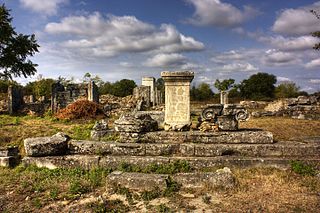
The classical town was planned according to the orthogonal system. The
network of streets, the forum surrounded by an Ionic colonnade and many
buildings, a two-nave room later turned into a basilica and other public
buildings have been uncovered. The rich architectures and sculptures show a
similarity with those of the ancient towns in Asia Minor. Nicopolis ad Istrum
had issued coins, bearing images of its own public buildings.
In
447 AD
, the town was destroyed by
Attila’s
Huns. Perhaps it was already abandoned before the early 400s. In the
6th century, it was rebuilt as a powerful fortress enclosing little more than
military buildings and churches, following a very common trend for the cities of
that century in the Danube area.The largest area of the extensive ruins (21.55
hectares) of the classical Nicopolis was not reoccupied since the fort covered
only one fourth of it (5.75 hectares), in the southeastern corner. The town
became an episcopal centre during the early Byzantine period. It was finally
destroyed by the Avar invasions at the end of the 6th century. A Bulgarian
medieval settlement arose upon its ruins later (10th-14th century).
Nicopolis ad Istrum can be said to have been the birthplace of
Germanic
literary tradition. In the 4th
century, the Gothic
bishop, missionary and translator
Ulfilas
(Wulfila) obtained permission from
Emperor
Constantius II
to immigrate with his flock of
converts to Moesia and settle near Nicopolis ad Istrum in 347-8. There, he
invented the
Gothic alphabet
and translated the
Bible
from
Greek
to
Gothic
.
Caracalla 198-217 A.D.
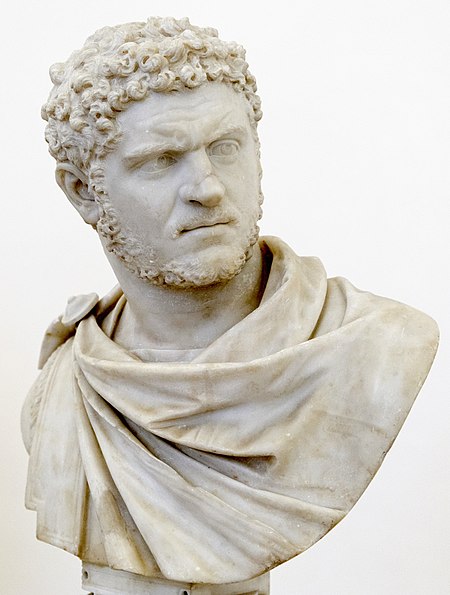
Caesar:
195-198 A.D. (under
Septimius Severus
)
Augustus: 198-217 A.D. (198-209 A.D. with
Septimius Severus
) (209-211 A.D. with
Septimius Severus
and
Geta
) (211 A.D. with
Geta
) (211-217 A.D. Sole Reign)
Son of
Septimius Severus
and
Julia Domna
| Brother of
Geta
| Husband of
Plautilla
| Nephew of
Julia Maesa
| Cousin of
Julia Soaemias
and
Julia Mamaea
|
Caracalla (Latin:
Marcus Aurelius Severus Antoninus Augustus;4
April 188 – 8 April 217) was
Roman emperor
from 198 to 217 The eldest son of
Septimius Severus
, for a short time he ruled
jointly with his younger brother
Geta
until he had him murdered in 211.
Caracalla is remembered as one of the most notorious and unpleasant of emperors
because of the massacres and persecutions he authorized and instigated
throughout the Empire.
Caracalla’s reign was also notable for the
Constitutio Antoniniana
(also called the
Edict of Caracalla), granting
Roman citizenship
to all freemen throughout the
Roman Empire
, which according to historian
Cassius Dio
, was done for the purposes of
raising tax revenue. He is also one of the emperors who commissioned a large
public bath-house (thermae)
in Rome. The remains of the
Baths of Caracalla
are still one of the major
tourist attractions of the Italian capital.
Early life
Caracalla, of mixed
Punic
–Roman
and Syrian
descent, was born Lucius Septimius
Bassianus in Lugdunum
,
Gaul (now Lyon
,
France
), the son of the later Emperor Septimius
Severus and
Julia Domna
. At the age of seven, his name was
changed to Marcus Aurelius Septimius Bassianus Antoninus to create a connection
to the family of the philosopher emperor
Marcus Aurelius
. He was later given the
Caracallanickname
,
which referred to the Gallic hooded tunic he habitually wore and which he made
fashionable.
Reign (211)
Murder of brother
(211)
His father died in 211 at
Eboracum
(now
York) while on campaign in northern Britain. Caracalla was present
and was then proclaimed emperor by the troops along with his brother
Publius Septimius Antoninus Geta
. Caracalla
suspended the
campaign in Caledonia
and soon ended all
military activity, as both brothers wanted to be sole ruler thus making
relations between them increasingly hostile. When they tried to rule the Empire
jointly they actually considered dividing it in halves, but were persuaded not
to do so by their mother.
Then in December 211 at a reconciliation meeting arranged by their mother
Julia, Caracalla had Geta assassinated by members of the Praetorian Guard loyal
to himself, Geta dying in his mother’s arms. Caracalla then persecuted and
executed most of Geta’s supporters and ordered a
damnatio memoriae
pronounced by the Senate
against his brother’s memory.
Geta’s image was simply removed from all coinage, paintings and statues,
leaving a blank space next to Caracalla’s. Among those executed were his former
cousin-wife
Fulvia Plautilla
, his unnamed daughter with
Plautilla along with her brother and other members of the family of his former
father-in-law
Gaius Fulvius Plautianus
. Plautianus had
already been executed for alleged treachery against emperor Severus in 205.
About the time of his accession he ordered the
Roman currency
devalued, the silver purity of
the denarius
was decreased from 56.5% to 51.5%, the
actual silver weight dropping from 1.81 grams to 1.66 grams – though the overall
weight slightly increased. In 215 he introduced the
antoninianus
, a “double denarius” weighing
5.1 grams and containing 2.6 grams of silver – a purity of 52%.
In the Roman provinces
In 213, Caracalla went north to the German frontier to deal with the
Alamanni
tribesmen who were raiding in the
Agri Decumates
. The Romans did defeat the
Alamanni in battle near the river
Main
, but failed to win a decisive victory over
them. After a peace agreement was brokered and a large bribe payment given to
the invaders, the Senate conferred upon him the empty title of Germanicus
Maximus. He also acquired the surname Alemannicus at this time. The
following year the tyrant traveled to the East, to Syria and Egypt never to
return to Rome.
Gibbon
in his work describes Caracalla as “the
common enemy of mankind”. He left the capital in 213, about a year after the
murder of Geta, and spent the rest of his reign in the provinces, particularly
those of the East. He kept the Senate and other wealthy families in check by
forcing them to construct, at their own expense, palaces, theaters, and places
of entertainment throughout the periphery. New and heavy taxes were levied
against the bulk of the population, with additional fees and confiscations
targeted at the wealthiest families.
When the inhabitants of
Alexandria
heard Caracalla’s claims that he had
killed Geta in self-defense, they produced a satire mocking this as well as
Caracalla’s other pretensions. In 215, Caracalla savagely responded to this
insult by slaughtering the deputation of leading citizens who had unsuspectingly
assembled before the city to greet his arrival, and then unleashed his troops
for several days of looting and plunder in Alexandria. According to historian
Cassius Dio, over 20,000 people were killed.[citation
needed]
Domestic Roman policy
Affiliation with
the army
During his reign as emperor, Caracalla raised the annual pay of an average
legionary to 675
denarii
and lavished many benefits on the
army which he both feared and admired, as instructed by his father Septimius
Severus who had told him on his deathbed to always mind the soldiers and ignore
everyone else. Caracalla did manage to win the trust of the military with
generous pay rises and popular gestures, like marching on foot among the
ordinary soldiers, eating the same food, and even grinding his own flour with
them.
With the soldiers, “He forgot even the proper dignity of his rank,
encouraging their insolent familiarity,” according to Gibbon. “The vigour of the
army, instead of being confirmed by the severe discipline of the camps, melted
away in the luxury of the cities.”
His official portraiture marks a break with the detached images of the
philosopher–emperors who preceded him: his close-cropped haircut is that of a
soldier, his pugnacious scowl a realistic and threatening presence. This rugged
soldier–emperor iconic archetype was adopted by most of the following emperors
who depended on the support of the troops to rule, like his eventual successor
Maximinus Thrax
.
Seeking to secure his own legacy, Caracalla also commissioned one of Rome’s
last major architectural achievements, the
Baths of Caracalla
, the 2nd largest public
baths ever built in ancient Rome. The main room of the baths was larger than
St. Peter’s Basilica
, and could easily
accommodate over 2,000 Roman citizens at one time. The bath house opened in 216,
complete with libraries, private rooms and outdoor tracks. Internally it was
lavishly decorated with gold-trimmed marble floors, columns, mosaics and
colossal statuary.
Edict of
Caracalla (212)
The
Constitutio Antoniniana
(Latin: “Constitution
[or Edict] of Antoninus”) (also called Edict of Caracalla) was an edict
issued in 212 by Caracalla which declared that all free men in the Roman Empire
were to be given full Roman citizenship and all free women in the Empire were
given the same rights as Roman women.
Before 212, for the most part only inhabitants of Italia held full Roman
citizenship. Colonies of Romans established in other provinces, Romans (or their
descendants) living in provinces, the inhabitants of various cities throughout
the Empire, and small numbers of local nobles (such as kings of client
countries) held full citizenship also. Provincials, on the other hand, were
usually non-citizens, although many held the
Latin Right
.
The Roman Historian
Cassius Dio
contended that the sole motivation
for the edict was a desire to increase state revenue.At the time aliens did not
have to pay most taxes that were required of citizens, so although nominally
Caracalla was elevating their legal status, he was more importantly expanding
the Roman tax base. The effect of this was to remove the distinction that
citizenship had held since the foundation of Rome and as such the act had a
profound effect upon the fabric of Roman society.
War with Parthia
According to the historian Herodian, in 216, Caracalla tricked the Parthians
into believing that he accepted a marriage and peace proposal, but then had the
bride and guests slaughtered after the wedding celebrations. The thereafter
ongoing conflict and skirmishes became known as the
Parthian war of Caracalla
.
Assassination (217)
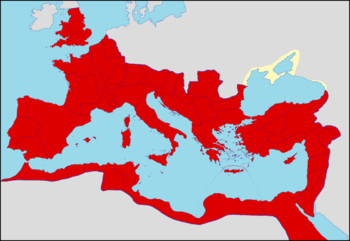
The Roman Empire during the reign of Caracalla.
While travelling from
Edessa
to continue the war with
Parthia
, he was assassinated while urinating at
a roadside near
Carrhae
on 8 April 217 (4 days after his 29th
birthday), by Julius Martialis, an officer of his personal bodyguard.
Herodian
says that Martialis’ brother had been
executed a few days earlier by Caracalla on an unproven charge; Cassius Dio, on
the other hand, says that Martialis was resentful at not being promoted to the
rank of centurion. The escort of the emperor gave him privacy to relieve
himself, and Martialis then ran forward and killed Caracalla with a single sword
stroke. While attempting to flee, the bold assassin was then quickly dispatched
by a Scythian archer of the Imperial Guard.
Caracalla was succeeded by his
Praetorian Guard Prefect
,
Macrinus
, who (according to Herodian) was most
probably responsible for having the emperor assassinated.
His nickname
According to
Aurelius Victor
in his Epitome de Caesaribus,
the agnomen
“Caracalla” refers to a Gallic
cloak
that Caracalla adopted as a personal
fashion, which spread to his army and his court. Cassius Dio and the
Historia Augusta
agree that his nickname
was derived from his cloak, but do not mention its country of origin.
Legendary king of
Britain
Geoffrey of Monmouth
‘s legendary
History of the Kings of Britain
makes
Caracalla a king of Britain, referring to him by his actual name “Bassianus”,
rather than the nickname Caracalla. In the story, after Severus’s death the
Romans wanted to make Geta king of Britain, but the Britons preferred Bassianus
because he had a British mother. The two brothers fought a battle in which Geta
was killed and Bassianus succeeded to the throne. He ruled until he was betrayed
by his Pictish
allies and overthrown by
Carausius
, who, according to Geoffrey, was a
Briton, rather than the historically much later
Menapian
Gaul that he actually was.
|










